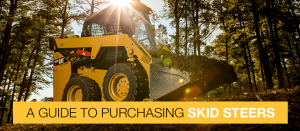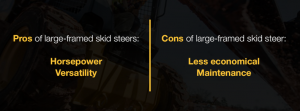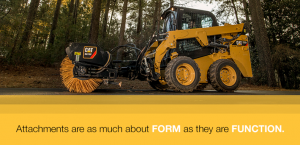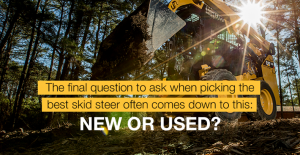Need a workhorse in the world of heavy equipment? A skid steer— commonly called a skid steer loader— is often the right machine for the job. For tasks that require lots of manual work, a skid steer is one piece of equipment well-suited for different tasks—from a construction site to a warehouse or even a farm. Skid steers differ from compact track loaders in that they have tires instead of tracks; CTLs are great for established job sites with flat surfaces and indoor applications.
Yet finding the right skid steer for your money—and your project—can be overwhelming considering the range of frame types and functionality.
Before you purchase (or even rent a skid steer), this buyer’s guide outlines everything you need to know to make an informed decision. You’ll learn how skid steers work, various attachments available, and what to know to make an informed decision.
Jump to Sections:
- 1. Skid-Steer Sizing and Specifications
- 2. What Horsepower Should a Skid-Steer Have?
- 3. How Do Hydraulics Power Skid Steers?
- 4. What Attachments Are Available for Skid Steers?
- 5. Skid Steer Technology
- 6. Buying a Used or New Skid Steer
1. Understand Skid Steer Sizing and Specifications
To choose the right skid steer for your project, consider the size and specifications best suited for your specific needs. Skid steers are versatile due to their rigid-frame builds, load balance, and maneuverability, but certain features may vary across sizes.
Always consult skid-steer size charts to compare variables like the unit’s engine model and horsepower to ensure the model meets typical project requirements.
Here are a few variables to consider and questions to ask before deciding on a skid steer.
- Terrain: What kind of terrain is your project taking place on? Flat or hilly, rocky or soft, rotated dirt? Is the environment wet or dry, compact or loose? How will the weight of your skid steer work against your job site’s environment?
- Usage: Consider all project details including what you expect to use the skid steer for, from loading and hauling to drilling, or excavating. How many hours a day will the steer be used, and what are the operating load weights or capacities you’ll need to match expected workloads? Does your desired unit have an engine model and horsepower fitting your projected use?
- Agility/maneuverability: Will your skid steer need to move within tight, limited spaces, like streets or busy construction yards? Or will it traverse open planes like farmland, ranches, or parking surfaces?
- Rated operating capacity (ROC): Skid-steer weight loads range widely across sizes. Smaller-framed units bear 1,500-2,000 lbs., whereas midsize to large units run ROCs up to 3,000 lbs.
Small-Frame Skid Steers
Compact or utility skid steers are some of the most versatile and efficient on the market. These small-framed machines’ operating capacity typically falls between 1,300-1,750 lbs. with a 50-70 horsepower (hp), lending them useful for projects with small job-site dimensions, difficult terrains, and tight spaces.
Pros of small-framed skid steers:
- Price: Small-framed units are the most affordable on the skid-steer market — perfect for the first-time buyer with standard usage needs.
- Compactness: While the units run smaller, their frames and builds are no weaker or less sturdy than their larger counterparts.
- Maneuverability: Compact skid steers can often turn in their own tracts and offer the most operating comfort.
Cons of small-framed skid steers:
- Lower operating weight: Small-framed skid steers have lower operating weights than larger models, which can impact their stability, especially when carrying heavy loads or operating on rough terrain. It may also affect their ability to push or lift heavy materials efficiently.
- Limitations on attachments: Smaller-frame skid steers (with smaller engines and horsepower) can’t provide the muscle for some specialty attachments like forestry mulchers, for example.
Large-Frame Skid Steers
Larger-frame skid steers typically have operating capacities starting in the 2,000 lbs. range, though it’s not uncommon to find brand units between 2,700-3,000 lbs. and with horsepowers in the 70s.
Pros of large-framed skid steers:
- Horsepower: Larger skid steers court larger horsepower, so you’ll have the muscle for all the attachments and hydraulic pump running you need.
- Versatility: From loading dump trucks to clearing brush to high-capacity rock saw attachments, larger-framed skid steers provide a dynamic canvass for your project’s grittier components.
Cons of large-framed skid steer:
- Less economical: You can expect to pay more for a larger-framed skid steer, which may not be the best investment depending on your use case
- Maintenance costs: Machine maintenance costs can be higher on larger units due to more wear and tear due to heavier loads and more complex hydraulic and electrical sys
2. What Horsepower Should a Skid Steer Have?
Next, consider the power of your unit. Brands increasingly include various power ratings when advertising skid steers to differentiate equipment by engine size.
- Power: The rate at which work is done. Power is measured using many standards, from watts and kilowatts to the complementary horsepower conversion.
- Horsepower: A unit’s power capability is measured by its ability to raise 550-foot-pounds per second or 33,000-foot-pounds per minute, representing the maximum sustainable power output. This measurement, known as horsepower, is widely used for engine types, including those found in skid steers. Some manufacturers may also provide engine power ratings, which are operationally identical to horsepower.
- Output: The variables affecting a skid steer’s overall power output include engine size, operating speeds, ROCs, and torque. Generally, the larger the engine size and horsepower, the larger the operating speed and the duration it can sustain its power output.
While the most popular machines typically range from horsepower in the lower 50s into the mid-70s, it’s not merely the raw number that makes or breaks a skid steer’s capabilities.
Horsepower also provides a machine’s natural traction and pull, determines what kinds of attachments you can use, and determines the running and maintenance of your hydraulic pumps.
3. How Do Hydraulics Power Skid Steers?
Skid steers are dual-powered through their diesel engines and hydraulic pumps and systems. Hydraulic systems use pressurized, hydraulic fluids to power their associated machinery, rather than other fuel sources or the raw flow of materials. They’re vital to the machine’s overall output and important in selecting the best skid for your project.
A skid steer’s hydraulics system also plays a large role in its maintenance requirements and full-power output.
Four central hydraulic pumps aid in the overall power output for skid steers; there are auxiliary hydraulic systems to understand.
Four Hydraulic Pumps Found in Skid Steers
- Two variable-displacement pumps create energy for two hydraulic-powered drive motors located in the mainframe of the skid steer.
- A larger fixed-displacement pump that provides the power needed for a skid steer’s loader arms and any attached accessories.
- A smaller fixed-displacement pump lends complementary hydraulic circulation for fluids throughout the engine filter, creating the pressure needed for the unit’s pilot controls.
Types of Auxiliary Hydraulic Systems
- Standard-flow auxiliary hydraulics package. A standard-flow system typically ranges from 17 to 25 gallons per minute (gpm). It is the auxiliary system you’ll find automated on nearly all skid steer models. These auxiliary systems work in tangent to power the most common unit attachments. Think of accessories such as buckets, hydraulic augers, and hammers, with average pressurization of 3,000 to 3,500 pounds per square inch (psi).
- High-flow auxiliary hydraulics package. A skid steer with a high-flow auxiliary hydraulics package provides enhanced attachment options, run times, and productivity. While they still operate under the same standard pressurization — 3,000-3,500 psi, they increase the pressure flow rate up to 38-40 gpm. High-flow systems can be added to new skid steers purchased directly from a manufacturer or built into used steers. High-flow hydraulics are needed when skid steer attachments like rock saws or landscaping mulchers require high-flow rates.
- Enhanced high-flow auxiliary hydraulics package. To get the most from your pound-per-square-inch flow, enhanced high-flow packages can be installed to boost a skid steer’s output to 4,000 psi. High-flow packages maintain similar gallon-per-minute rates as their high-flow counterparts; some attachments require enhanced high-flow packages because they need maximum hydraulic pressure to operate.
4. What Attachments Are Available for Skid Steers?
You have a variety of attachments to choose from that can determine the ideal size and power rating (including hydraulic systems) for your ideal skid steer.
Check out our post on the best skid steer attachments to find the right attachment for your project and how they work.
Attachments are as much about form as they are function and must be compliant with your skid steer’s safe carrier operating specifications, flow rates, horsepower, and ROCs.
Common skid-steer attachments
- Augers: Augers allow for smooth and seamless ground boring. Across soil states and varieties, augers offer different speed and torque options to dig through and extract dirt without problematic engine stalling. Explore the various auger bits on the market to find one that is best designed for your site’s terrain.
- Backhoes: Nothing beats a backhoe for superior digging and excavation with your skid steer. These attachments are controlled inside the cab, designed and engineered to allow digging and shifting from the operator’s seat. Certain new skid steer models can come equipped with optional auxiliary hydraulic backhoe lines for attaching further hammers, augers, thumbs, and other accessories for maximum digging utility.
- Blades: Blades scoop, move, and smooth over materials in various landscaping and construction applications. Their smooth surfaces, angled dimensions, and reversible cutting edges mean you can cut and push rocks, dirt, snow, and more—all in one swoop.
- Brushcutters: Brushcutters make it easy to handle any project requiring landscaping, gardening, farming, or general interaction with overgrowth greenery.
- Buckets: What is a skid steer without its bucket? The two go hand-in-hand across the most basic and complex skid-steer applications. Engineered buckets attach seamlessly to their skid steers and aid in digging, loading, and transferring materials. Buckets also come with a range of specialized teeth, heights, and widths. You’ll want a bucket capacity designed to handle a variety of materials you commonly transport like snow and rock, or a grapple bucket for logs and difficult-to-handle material.
- Hammers: Hammers provide reliable performance for breaking through hard surfaces on the job, from sheetrock to concrete. Designed for high-impact blows per minute, they absorb vibrational recoil to minimize impact on the skid steer. Many new or used hammers have automatic shut-off and sound-buffering features for enhanced safety and noise control.
- Trenchers: Trenchers are a staple attachment for skid steers in farming applications. They efficiently cut uniform, narrow trenches through compact soil, with adjustable components and chain modifications based on the trench specifications.
- Rakes: For industrial-grade landscaping tasks like land clearing, sorting, digging, and aerating, rakes are highly versatile skid-steer attachments. Available in various configurations, they feature hardened teeth and hoppers of different sizes to suit specific land-clearing requirements, making them indispensable for heavy outdoor operations.
These are only a number of the dozens of skid steer attachments. Consider your project requirements to determine the different attachments you need, which you can reference with the horsepower and hydraulic capabilities of certain skid steer models.
5. Skid Steer Technology to Understand and Consider
Carolina Cat’s skid steers come engineered with the latest Cat-branded developments and service solutions. Construction technology spans a few different categories, but some of these systems are specific to skid steers.
Fleet Management Solutions
Advanced fleet management software— like Cat’s VisionLink®—is designed for remote and on-site visibility of skid steer operations and tracks the performance of skid steers in your fleet. This software provides comprehensive security, maintenance, production, and efficiency reports to improve overall performance.
Tier 4 Technology
Tier 4 technology refers to advanced upgrades in skid steers to meet more strict Tier 4 emissions standards, and is a good way to improve the efficiency and lifespan of older skid steers. Tier 4 technology optimizes engine performance, reduces fuel consumption, and lowers harmful emissions through engine electronics, fuel, and air systems modifications, including exhaust after-treatment.
Grade Control Earth Moving Solutions
Grade control and earth-moving technology can be installed on skid steers to boost precision and efficiency in landscaping and other use cases. Caterpillar offers two technological solutions for improved skid steer landscaping operations: the AccuGrade™ Grade Control System and the Computer-Aided Earthmoving System (CAES) for landfills.
Vital Information Management Systems
A staple of Cat’s overall tech solutions, your local Cat dealer can create a complete data management system for your skid steers that integrates data for unit oversight, productivity, safety, and sustainability best practices.
Other Skid Steer Technologies
Both new and used Cat skid steers have a crucial technological component network to keep machines functioning smoothly and easily. Here are a few of these systems:
No mechanical transmission: Each side of a skid steer loader is powered by a premium hydraulic motor. These two motors connect to a partner sprocket, and each sprocket connects through industrial chains to the wheels. This design allows the power generated by the motors to be evenly distributed to the wheels, reducing gear wear and increasing wheel torque capabilities. The no-mechanical transmission design has stood the test of time.
Powertrain: The overall powertrain design of a skid steer is based on the combination of a diesel engine and hydraulic pumps. This provides unparalleled efficiency compared to gasoline engines and can withstand the demands of 8-12 hour workdays on any industrial site.
Quick coupler systems: New, brand-name skid steers are designed to be used with tool attachments that universally lock into place with your hydraulic flow rates. This means you don’t have to worry about leakage or time-consuming attachment swaps between functions.
6. Buying a Used or New Skid Steer
The decision to purchase a new or used machine ultimately depends on your project requirements, budget, and preferences. For example, investing in a used skid steer loader in good condition might be a good idea compared to new machines with a higher price tag. But not always.
While buying used can be a good option in many cases, with new machines you can generally expect lower long-term maintenance costs, and newer features may boost productivity and financing.
In this section, we’ll discuss more pros and cons of buying a new vs. used to help you decide what’s right for your business.
Pros of buying a new skid steer
- Extended two-year warranty: The quality inspections, coverage, and care that come with skid steer warranties are hard to beat. Caterpillar’s twenty-four-month or 2,000-hours warranty offers twice the coverage on compact machines like skid steers, protecting against unexpected repairs or maintenance. What’s more, Cat Financial Services bolsters warranties with a complete suite of Equipment Protection Plans (EPP), customizable when starting at 36 months, as well as Customer Support Agreements and Engine Warranty Registration.
- Opportune financing: Many skid steer dealers offer flexible payment plans and bi-yearly financing terms for those who qualify. At participating Cat dealers, current offers allow you to purchase a new skid steer loader with a two-year standard warranty at 0 percent APR. You can further mitigate financial risks through Cat Insurance, which provides additional services and resources to protect your investment.
- Tax benefits: In some cases, you can write off your new equipment purchases in Section 179 of your tax deductions.
- Fresh, corrosion-resistant coatings on metal components: Coatings on new machines can help protect metal parts on your skid steer for longer when properly maintained.
Cons of buying a new skid steer
- Upfront cost: Even with financing options readily available, skid steers are a major red line on the budget.
- Depreciation: The first few years of ownership see the most value depreciation for a skid steer, which owners need to know.
If you’re considering jumping into the used market, it’s best to always browse used equipment from a reputable dealer like Carolina Cat. A skid steer purchased from an individual without maintenance records may have unseen issues, have lots of previous owners you’re unaware of, and be a bad long-term investment.
Pros of buying a used skid steer
- Affordability: Fewer credit restrictions and lower up-front costs make pre-owned skid steers attractive for many.
- Limited warranty: Some used models may still include inspections, product histories, and a lighter warranty.
- Brand & machine dealerships: Servicing your machine is inevitable. Ensure your skid steer has parts readily available and qualified dealers nearby to service the machine.
Cons of buying a used skid steer
- Condition. Used machines in poor condition can be difficult to spot to the untrained eye; seek professional help to determine hydraulic leakage, tire conditions, and even the condition of attachment pins or bushings.
- Appearance. Paint chips, rust, and corrosion can detract from your brand and indicate the likelihood of problems in the future.
Add Cat Skid Steers to Your Equipment Inventory Today
Considering a new used or rental skid steer? Take the first step and contact Carolina Cat for any questions and to receive a free quote.
Once you experience the difference of a Cat skid steer, you’ll see why these versatile machines are so popular and loved. Browse our complete inventory of construction equipment today to find the right equipment for your operation.





